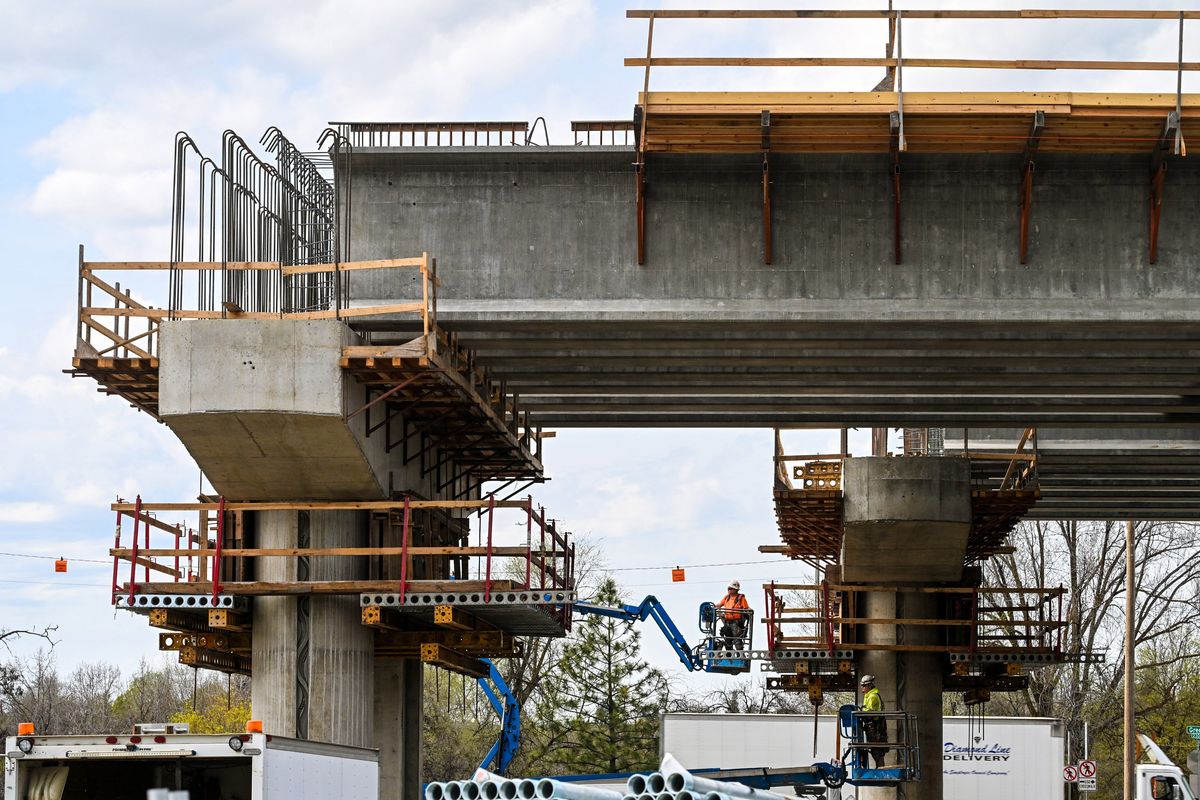Getting There: Finally fully funded, North Spokane Corridor on track for completion in 2030

If you spend your weekday commutes daydreaming about driving 60 mph (stoplight free!) through north Spokane and shaving 20 minutes off yourjourney, a zippier future is likely on your not-so-distant horizon.
The final push in constructing the long -anticipated North Spokane Corridor is underway, and developers say the 10.5-mile highway is entirely funded and on track to be completely finished by 2030.
Ryan Overton, a communications manager with the state Department of Transportation, and Terrence Lynch, the agency’s lead project engineer designing the corridor, say the state is making fast progress to finish the remaining 3.5 miles of the corridor.
“It’s fully funded,” Overton said. “There’s, you know, a big perception that it’s never going to get built and there’s no money for it. It’s there; the Legislature just appropriates so much for construction every two years.”
As construction carries on through the spring and summer, it will bring some noteworthy road and river closures in Spokane.
Beginning April 15, Euclid Avenue between Ralph and Market streets will be closed until May 31 to reconstruct the road under the corridor overpass. During the construction, drivers will be directed by signs to follow a detour via North Market Street to East Wellesley Avenue and North Freya Street.
Crews will use the closure to tear up the road on Euclid, put in a new grind and inlay of hot mix asphalt, add curbing and put in new sidewalks, Overton said.
As spring sunshine delights Spokanites after a long, dreary winter, the state transportation agency is reminding people that the Spokane River remains closed at the Greene Street Bridge due to ongoing construction of the corridor’s river crossing. Kayakers and tubers are advised to steer clear.
“We’ve had some issues with some recreationalists,” Overton said. “Stay out of the area, because we’ll have to stop work if people do decide to come down through the river due to safety concerns. That can delay us.”
The river crossing portion of the corridor is slated to be finished in 2025, Overton said.
Part of the final push to complete the corridor will be constructing its massive interchange with Interstate 90. That portion of the construction will be broken up into four separate projects and is scheduled to begin in late 2025.
“These are long-term projects,” Lynch said. “That’s a really, really large interchange. It’s over a quarter-billion dollars to build that.”
All told, there’s still $500 million worth of work to be done to finish building the corridor. That money is all secured, thanks to the Connecting Washington funding package passed by the state Legislature in 2015. The $16 billion statewide transportation investment is funded by an 11.9-cent gas tax increase phased in in 2016.
The funding gets allocated to the North Spokane Corridor every two years when state lawmakers draft Washington’s budget.
“It’s just spread out over so many years, which is why you see segments being built,” Overton said. “We can’t build the freeway all at once in its expanse because the funding just doesn’t allow for that. So we’ve broken it down into bite-sized projects.”
Much of the corridor north of the Spokane River passes through property owned by Union Pacific and BNSF Railway. Engineers on the project have had to work to coordinate how the freeway will pass over the railroads.
“Buying all the right-of-way is always a challenge,” Lynch said. “We’re still not done with all the right-of-way. We’re close, but we still have roughly 10 to 12 parcels that we haven’t acquired yet.”
Coordinating relocation of utilities while engaging with community members affected by the project has been another hurdle, Lynch said.
“What sort of elements and features and stuff can we include with the project – legally, because you can only spend transportation dollars on some things – to make it a project that’s built for the people?” he said.
As crews build farther south, construction will continue to pop up in more densely populated parts of Spokane.
“We’re going to be a raised structure all the way until we connect to I-90,” Overton said. “I think we’ve got 1,000 girders to go.”
In the coming years, officials say keeping people moving along I-90 during construction of the interchange will be a challenge. People can expect traffic delays and slowdowns on I-90 in the next five years. Crews will have to close lanes of the interstate for construction, Lynch said, but they plan to pick times when traffic flow is lower and try to be strategic.
“There’s no way you can build four bridges over I-90 without impacting I-90,” Lynch added.
It’s too early to tell when, exactly, those slowdowns will take place, but Lynch and Overton said they won’t begin for at least another couple of years.
In 2022, the average daily traffic volume on completed portions of the corridor surpassed 12,000 vehicles. But once the project is complete, officials expect that number to increase as traffic moves from Division Street to the corridor.
As it nears completion, the state Department of Transportation is coming up on the $1 billion mark spent on the North Spokane Corridor.
“That could be perceived in a good way or a bad way,” Lynch said. “Some people are like, ‘Oh, that’s too much money.’ But that’s a pretty big milestone for a project that’s been under construction for 23 years now. I think that’s kind of a cool fact for enginerds like myself.”